Mortgage and landlord possession statistics: July to September 2021
Published 11 November 2021
1. Main Points
This publication provides mortgage and landlord possession statistics for July to September 2021, and in general we have compared to the same quarter in 2019 (2019 has been used as a pre-Covid-19 baseline). Should users wish to compare latest outturn against 2020, they can do so using the accompanying statistical tables. For technical detail, please refer to the accompanying supporting document.
| All possession actions by both landlords and mortgage providers have reduced significantly following Covid-19 impact and associated actions | The Financial Conduct Authority (FCA) announcements and the passing of the Coronavirus Act in March 2020 means that possession actions of all types initially dropped to unprecedentedly low levels and are now starting to recover. As a result, the data is unlikely to be representative of general trends in possession actions. Caution should therefore be used when interpreting and applying these figures. |
| Mortgage claims, orders, warrants and repossessions have decreased significantly when compared to pre-Covid levels | Compared to 2019, pre-Covid-19 mortgage possession claims, orders, warrants and repossessions by county court bailiffs have decreased by 59%, 70%, 81% and 68% respectively. However, compared to the same quarter in 2020, all mortgage actions increased by over 100%. This is in line with the recovery referred to above. Mortgage possession claims increased from 109 to 2,833, orders from 25 to 1,235, warrants from 24 to 933 and repossessions by county court bailiffs increased from zero to 385. |
| Landlord possession actions have also all decreased significantly | The pattern is repeated for landlord possession actions. When compared to the same quarter in 2019, landlord possession claims, orders, warrants and repossessions by county court bailiffs have decreased by 64%, 75%, 69% and 35% respectively. However, when compared to the same quarter in 2020, over 100% increases were recorded across all actions. Possession claims rose from 3,956 to 10,202, orders from 131 to 5,600, warrants from 919 to 4,492 and repossessions from zero to 4,853. |
| Mortgage and Landlord possession claims, and repossession rates have fallen across all regions | Decreases in possession claims have been recorded over all regions. Landlord claims remained concentrated in London (with 7 of the highest 10 claim rates). |
| Mortgage median average time (from claim to repossession) has increased to 115 weeks | The median average time from claim to mortgage repossession has increased to 114.6 weeks, up from 32.6 weeks in compared to the same period in 2019. In the same quarter in 2020, there were no repossessions due to policy interventions. |
| Median timeliness for landlord repossessions has increased to 68 weeks | The median average time from claim to landlord repossession has increased to 68.4 weeks, up from 20.1 weeks in the same period in 2019. Similarly, there were no landlord repossessions in the same quarter 2020 due to policy interventions. |
A data visualisation tool has also been published this quarter that provides further breakdowns in a web-based application. The tool can be found here.
Note that due to the coronavirus and its impacts we have included an annex at the end of this publication covering possession-related activity over the last year. Please note that due to continued recovery, this will be the last time we publish this annex focusing on the Coronavirus period.
For feedback related to the content of this publication and visualisation tool, please contact us at CAJS@justice.gov.uk
2. Statistician’s Comment
This quarter, there has been continued recovery in all court actions although numbers remain well below pre-Covid-19 levels. We would usually compare the data from this quarter with the same period in the previous year. However, given the seismic events over the last year and the impact these have had on 2020 data, for this report we are continuing to provide a comparison for the equivalent quarter in 2019 (as a pre-Covid-19 baseline). This should allow for a more meaningful comparison of trends and performance and a better measure of how the possessions process “returns to normal”. We expect to return to the usual practice from next year, when the Covid-19 impact is likely to have washed out of the data. Should users wish to compare latest outturn against 2020, they can do so using the accompanying statistical tables.
Mortgage and Landlord possession claims continue to increase gradually but remain considerably below pre-Covid-19 levels following the lifting of the bailiff restrictions. Private landlord claims account for the largest proportion of total landlord claims, with 43% in Q3 2021. This contrasts with pre-Covid-19 trends where the majority were social landlord claims.
Possession and enforcement actions returned in June and July following the end of stays in England (31st May) and Wales (30th June). The number of repossessions therefore more than trebled this quarter compared to the previous quarter reported, although they were still well below pre-Covid-19 levels – 385 Mortgage and 4,853 Landlord repossessions with a median average time of 115 and 68 weeks respectively.
The increase in timeliness noted over the past few quarters reflect the stay on most possession claims implemented for case progression and the stay to evictions. Those cases that are able to progress to repossession therefore include the duration of the stay within their timeliness calculations. Therefore, the volatility recorded in the numbers presented, should be considered within the context of small volumes and the invariable additional time needed where normal court procedures could not be followed.
We expect a continued increase in volume across all actions as the courts continue to manage the backlog while also dealing with new cases. Various measures have been put in place to ensure that HMCTS can manage this incoming workload. The measures include changes to the Civil Procedure Rules, such as the requirement to file a reactivation notice in older claims and provide the court with information of the impact of the pandemic on a tenant and their household.[footnote 1]
We introduced an Annex in the January to March 2020 publication to highlight the impact of Covid-19-related action on the possession process. Following on from the end of the stay on evictions and other Financial Conduct Authority (FCA) guidance, as well as a recovery to court activity, this quarter’s Annex will be the last. We will return to our normal publication from next quarter.
3. Overview of Mortgage Possession
Mortgage possession actions are slowly recovering from the impacts of Covid-19, with claims, orders and warrants currently around 59%, 70% and 81% below pre-Covid levels in Q3 2019.
As a result of coronavirus and associated actions, all mortgage possession actions have dropped significantly. Compared to the same quarter in 2019, mortgage possession claims (2,833) are down 59%. Mortgage orders for possession (1,235) are down 70%, warrants issued (933) are down 81% and repossessions (385) are down 68%.
Figure 1: Mortgage possession actions (actual and seasonally adjusted) in the county courts of England and Wales, July to September 2016 to July to September 2021 (Source: Table 10a)
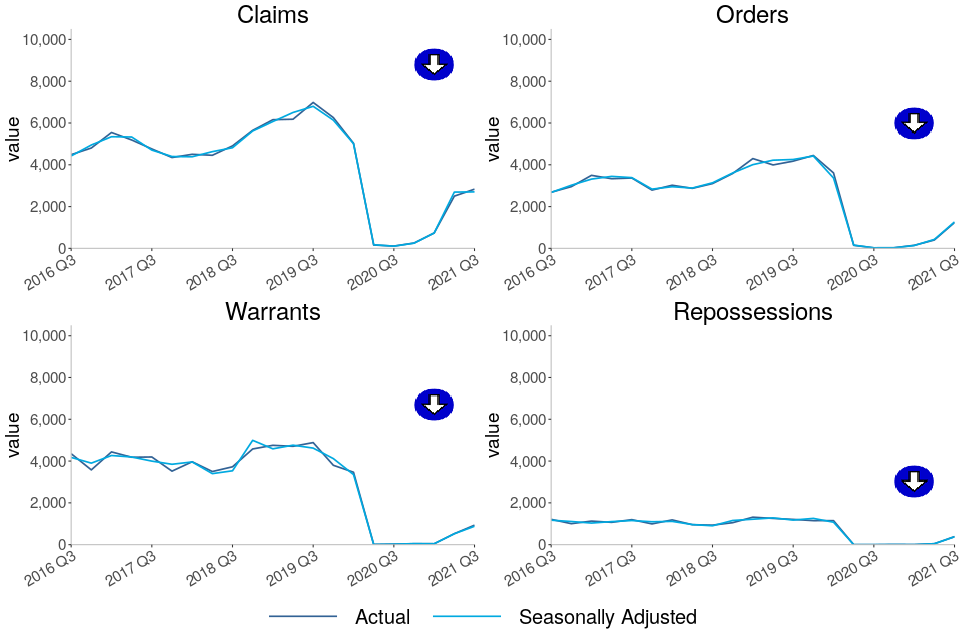
Mortgage possession claims fell from a peak of 26,419 in April to June 2009 before stabilising from April to June 2015 (4,849, see table 10a). In the most recent quarter, July to September 2021, there were 2,833 claims for possession, down 59% from the same quarter in 2019.
Orders and warrants for possession followed a similar trend to mortgage claims, falling from a peak of 23,850 orders in July to September 2009 and 21,350 warrants in January to March 2009, and stabilizing around 2016/17. Compared to the same quarter in 2019, orders are down 70% to 1,235 and warrants are down 81% to 933 in July to September 2021.
Historically, repossessions by county court bailiffs fell from a high of 9,284 in Q1 of 2009 to 934 in Q3 of 2018, the lowest recorded level of the series at the time. Following the complete cessation of repossession proceedings from March to September 2020 where no repossessions took place, the FCA guidance advised mortgage lenders not to commence or continue possession proceedings until April 2021 (unless there were special circumstances). As a result, there were only 10 repossessions over the whole of last year from April 2020 to March 2021 (q2 2020 to q1 2021), and only 385 repossessions in July to September 2021, down 68% compared to the same quarter in 2019.
Before the impact of coronavirus, the historical fall in the number of mortgage possession actions since 2008 has generally coincided with lower interest rates, a proactive approach from lenders in managing consumers in financial difficulties and other interventions, such as the Mortgage Rescue Scheme and the introduction of the Mortgage Pre-Action Protocol. Additionally, the downward trend seen in recent years mirrors that seen in the proportion of owner-occupiers.
4. Mortgage Possession Action Timeliness
Median timeliness figures are volatile for mortgage orders, warrants and repossessions due to low volumes being processed and the impact of Covid-19 on these low volumes
Median average time has increased for orders and warrants. However due to the low volumes of possession actions this quarter, caution should be used when interpreting these results. It is unlikely that these timeliness figures are representative of any statistical trend and instead reflect the pause in actions.
The median average time from claim to repossession has increased to 114.6 weeks, up from 32.6 weeks in the same period in 2019. However, it should be noted this is based on much fewer cases.
Figure 2: Average timeliness of mortgage possession actions, July to September 2016 to July to September 2021 (Source: Table 3)
Number of weeks taken from initial mortgage claim to…
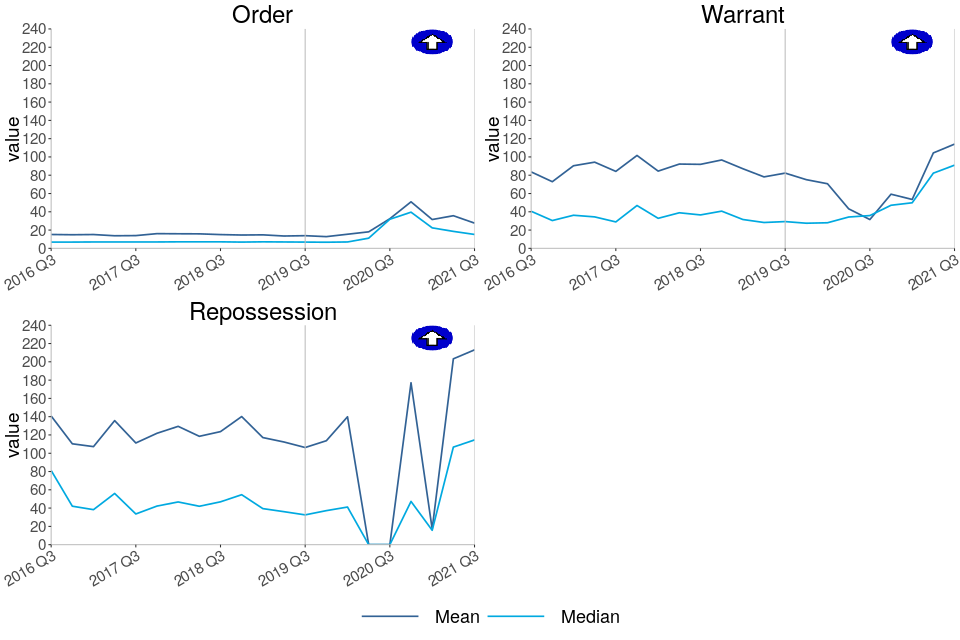
-
Claims to order median timeliness has increased to 15.2 weeks, up from 6.9 weeks in the same period in 2019.
-
Claims to warrant median timeliness has increased to 91.0 weeks, up from 29.3 weeks in the same period in 2019.
-
Claims to repossession median timeliness has increased to 114.6 weeks, up from 32.6 weeks in the same period in 2019.
The above charts distinguish between the timeliness of possession claims at different stages of a case. Average time taken from claim to warrant or repossession can fluctuate and is affected by various factors. For example, the final two charts take account of the amount of time between the court order being issued and the claimant, such as the mortgage lender, applying for a warrant of possession.
The short-term increases noted over the past few quarters reflect the stay on most possession claims implemented between March and September 2020 for case progression and the stay to evictions (with some exceptions) implemented between March 2020 and June 2021. Those cases that have progressed to repossession therefore include the duration of the stay within their timeliness. This “hold stay period” will form part of many possession actions over the next few quarters.
The long-term increases in the mean average time from claim to warrant and claim to repossession are due to an increasing proportion of historic claims (dating from 2007 to 2013) reaching the warrant and repossession stages respectively in recent quarters. This is possibly due to defendants recently breaking the terms of the mortgage agreements put in place at the start of the process. Although these historical outlying cases inflate the mean average, they have less effect on the median.
5. Overview of Landlord Possession
The number of landlord possession actions for all court stages have increased compared to the same quarter of last year but remains significantly reduced in comparison to the same quarter in 2019.
As a result of coronavirus and associated policy actions, all landlord possession actions have dropped significantly. Compared to the same quarter in 2019, landlord possession actions; claims (10,202), orders for possession (5,600), warrants (4,492) and repossessions (4,853) have decreased by 64%, 75%, 69% and 35% respectively.
Figure 3: Landlord possession actions (actual and seasonally adjusted) in the county courts of England and Wales, July to September 2016 to July to September 2021 (Source: Table 10b)
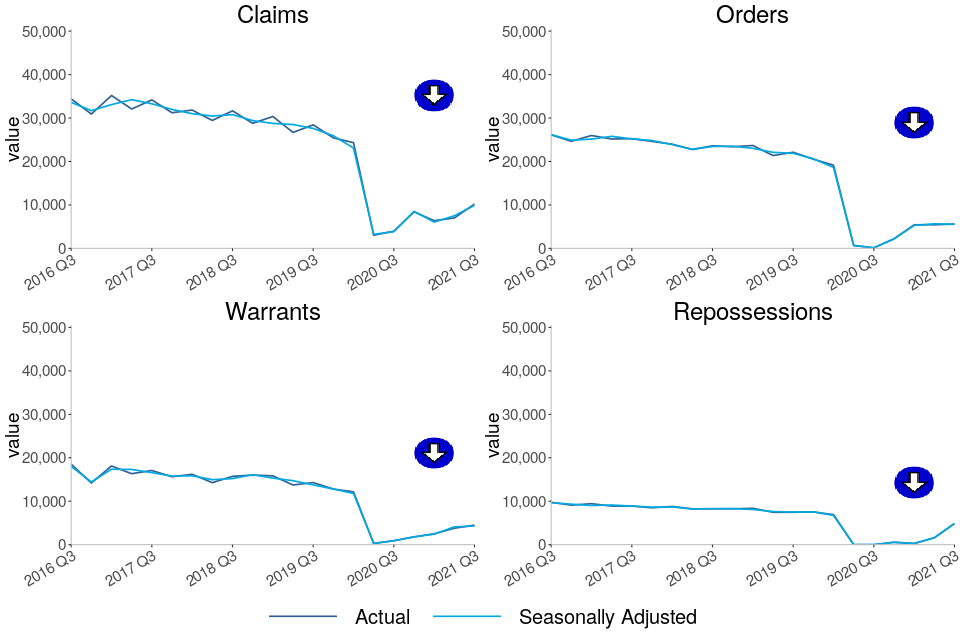
In July to September 2021, a far fewer proportion (36% or 3,681) of all landlord possession claims were social landlord claims, and 21% (2,148) were accelerated claims. The group making up the largest proportion of landlord claims (43% or 4,373) were private landlord claims.
This contrasts with previous quarters. For example, in July to September 2019, the majority (62% or 17,629) of all landlord possession claims were social landlord claims, and accelerated claims and private landlord claims made up just 17% and 21% of all landlord claims respectively.
The fall in claim and orders volumes is observed across all geographical regions. As in previous quarters, a concentration was seen in London, with 2,712 landlord claims and 1,537 landlord orders at London courts in July to September 2021, accounting for 27% of all landlord possession claims and orders respectively. Despite this, in London, there was still a decrease of 59% (from 6,638) for landlord claims and a decrease of 67% for landlord orders (from 4,724 in July to September 2019).
The 69% decrease in landlord warrants compared to July to September 2019, was again accompanied by large decreases across all regions. The largest regional number (1,410) was found in London, making up 31% of all landlord warrants. Despite this, there was a decrease of 60% for landlord warrants in London (from 3,542 in July to September 2019 to 1,410 in July to September 2021).
6. Landlord Possession Timeliness[footnote 2]
Median timeliness figures are volatile for landlord orders, warrants and repossessions due to low volumes being processed and the impact of Covid-19 on those low volumes
Median and mean average time has increased for orders, warrants and repossessions. However due to the low volumes of possession actions this quarter, caution should be used when interpreting these results. It is unlikely that these timeliness figures are representative of any statistical trend and will instead reflect the pause in actions.
The median average time from claim to repossession has increased to 68.4 weeks, up from 20.1 weeks in the same period in 2019.
Figure 4: Mean and median average timeliness of landlord possession actions, July to September 2016 to July to September 2021 (Source: Table 6)
Number of weeks taken from initial landlord claim to…
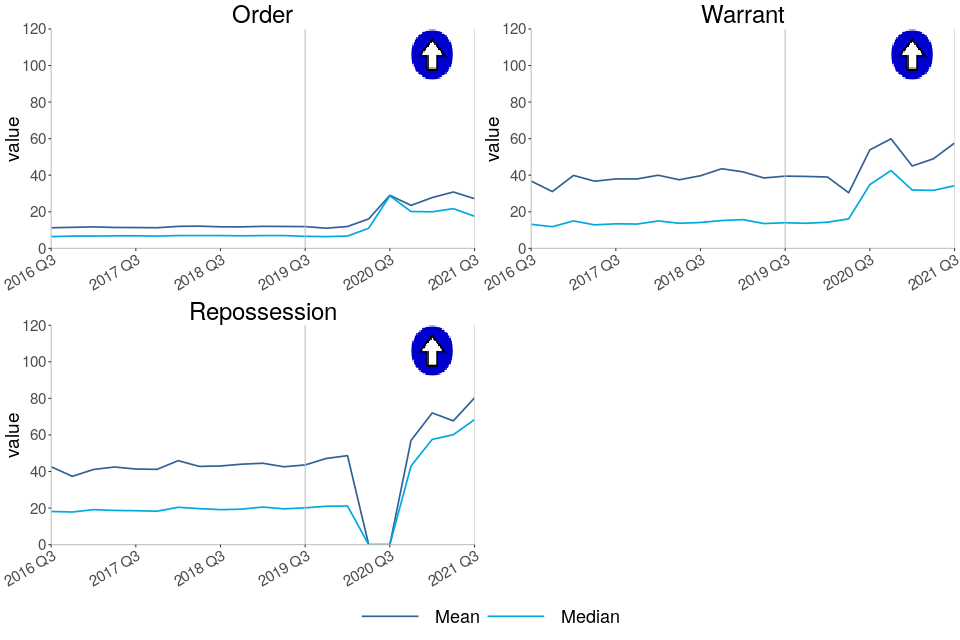
-
Claims to order median timeliness has increased to 17.6 weeks, up from 6.6 weeks in the same period in 2019.
-
Claims to warrant median timeliness has increased to 34.3 weeks, up from 14.0 weeks in the same period in 2019.
-
Claims to repossessions median timeliness has increased to 68.4 weeks, up from 20.1 weeks in the same period in 2019.
The short-term increases noted over the past few quarters reflect the stay on most possession claims implemented between March and September 2020 for case progression and the ongoing stay to evictions (with some exceptions). Those cases that have progressed to repossession therefore, include the duration of the stay within their timeliness. This “hold stay period” will form part of many possession actions over the next few quarters.
As shown by Figure 4, median figures are generally considerably lower than mean figures, demonstrating that on average, the progression from claim to successive stages can be positively skewed by outlying cases when using a mean measure of average timeliness.
7. Regional Possession Claims
Hyndburn in the North West region had the highest rate of mortgage possession claims at 39 per 100,000 households, followed by Pendle (North West region) and Epping Forest (East of England region); with 33 and 29 claims per 100,000 respectively. Note that these rates are based on relatively low numbers and so the relativities between areas should be treated with caution.
The majority of the highest landlord possession claim rates were found in London, with 7 of the 10 highest rates occurring in this region. Newham had the highest rate (154 per 100,000 households).
Figure 5: Mortgage possession Claims per 100,000 households, July to September 2021 (Source: map.csv; see supporting guide)
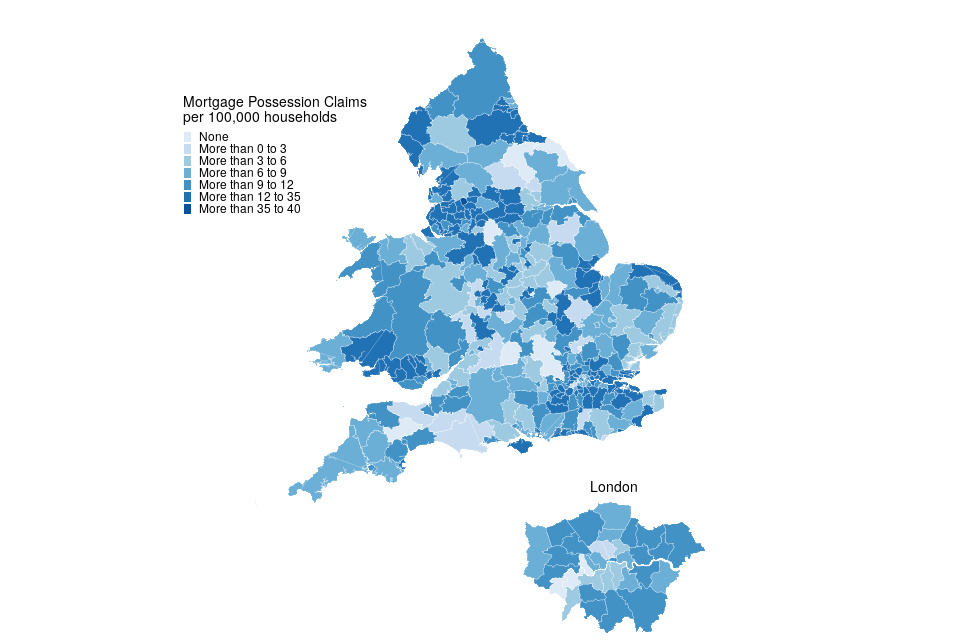
| Local Authority | Rate (per 100,000 households) | Actual number |
|---|---|---|
| Hyndburn | 39 | 14 |
| Pendle | 33 | 13 |
| Epping Forest | 29 | 16 |
8 local authorities had no possession claims during this period. Excluding these, Richmond upon Thames had the lowest rate of mortgage claims (1.2 per 100,000 households).
Figure 6: Landlord possession Claims per 100,000 households, July to September 2021 (Source: map.csv; see supporting guide)
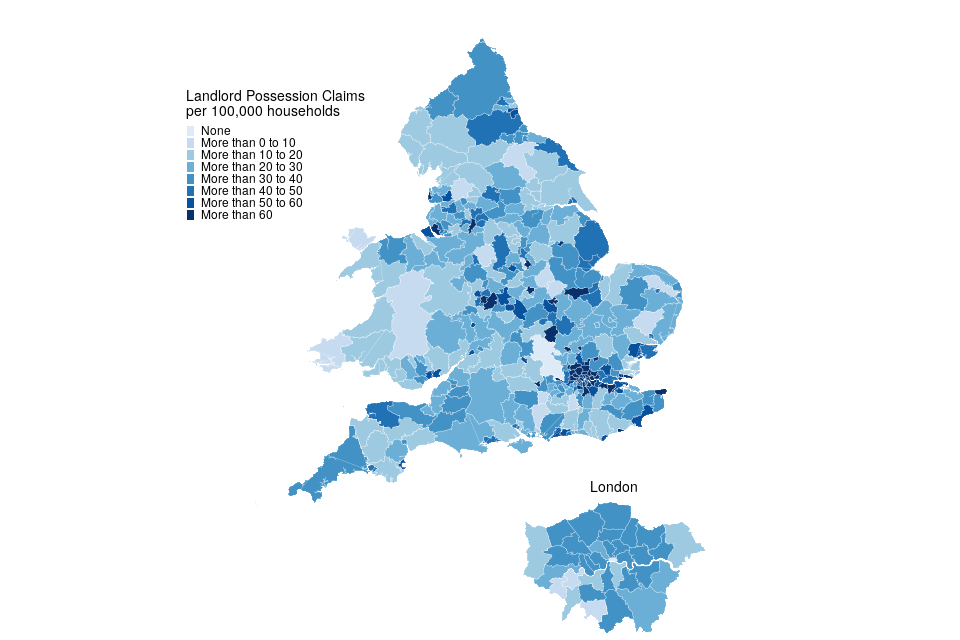
| Local Authority | Rate (per 100,000 households) | Actual number |
|---|---|---|
| Newham | 154 | 177 |
| Luton | 119 | 92 |
| Lewisham | 116 | 152 |
London boroughs account for 7 of the 10 local authorities with the highest rate of landlord claims.
There were no local authorities with zero landlord claims during this period. Melton had the lowest rate of landlord claims (4.4 per 100,000 households).
8. Regional Repossessions (by County Court Bailiffs)
South Tyneside had the highest overall rate of mortgage repossessions at 13 per 100,000 households.
Landlord repossessions were highest in Harlow with 118 per 100,000 households. Landlord repossessions were concentrated in London (4 out of the 10 highest rates).
Figure 7: Mortgage repossessions per 100,000 households, July to September 2021 (Source: map.csv; see supporting guide)

No repossessions by county court bailiffs were recorded during this period in 151 local authorities.
Figure 8: Landlord repossessions per 100,000 households, July to September 2021(Source: map.csv; see supporting guide)
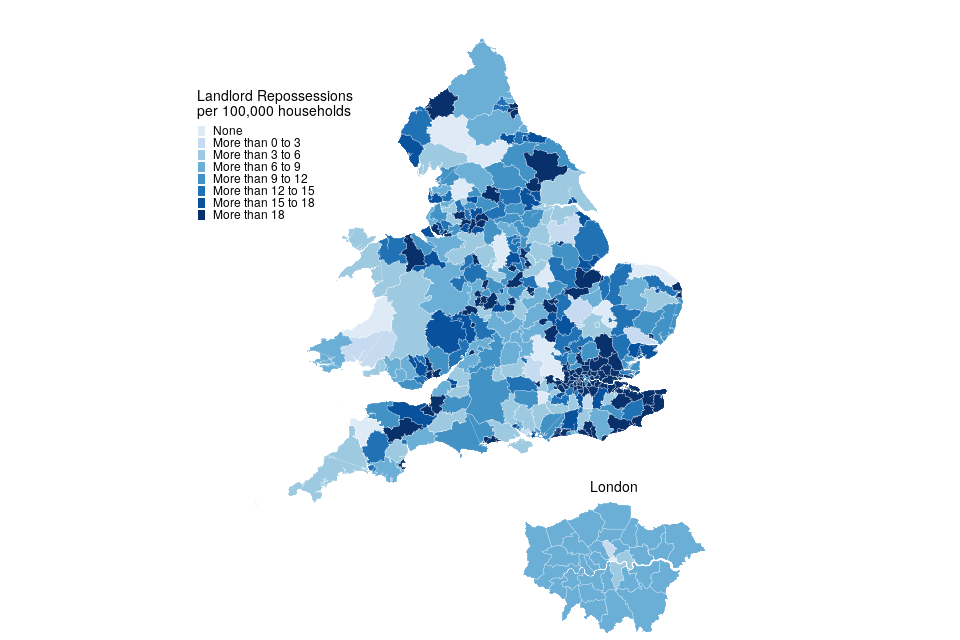
| Local Authority | Rate (per 100,000 households) | Actual number |
|---|---|---|
| Harlow | 118 | 42 |
| Dover | 89 | 47 |
| Folkestone and Hythe | 86 | 45 |
London local authorities account for 4 of the 10 boroughs with the highest rate of landlord repossessions.
11 local authorities had no landlord repossessions by county court bailiffs in July to September 2021.
9. Annex: Impact of changes in possession process related to Coronavirus
To respond to the coronavirus pandemic, there have been a number of policy interventions in the possession process. These have had an impact on possessions data since March 2020 and this annex provides a monthly breakdown of this data.
This is the final Annex, showing the impact of the changes in the possession process related to Coronavirus, to be included in the Mortgage and Landlord Possession Statistics. Subsequent publications will revert to reporting Quarterly volumes and timeliness.
For information and guidance about the possession process please see the below links:
- Landlord cases: Understanding the possession action process
- Mortgage cases: Repossession
9.1 Possession process
There was a stay on most possession proceedings in the county court which, having twice been extended, was in place between 27 March and 20 September 2020[footnote 3] [footnote 4] [footnote 5]. Possession claims could be made during the stay but could not progress through the court until this was lifted.
The courts began to process possession cases from 21 September 2020. However, under Financial Conduct Authority (FCA) guidance, mortgage lenders were advised not to commence or continue possession proceedings against customers until 31 October 2020[footnote 6]. This was later amended, with mortgage firms being advised that they could commence or continue possession proceedings but not seek to enforce repossessions before 31 January 2021, later extended to 1 April 2021[footnote 7]. During April to June 2021, repossession in mortgage cases was restricted in England and Wales by legislation (see below, 9.3. Enforcement actions by bailiffs).
Possession claims made before 3 August 2020 with no possession order made prior to 27 March 2020 needed to be reactivated after the end of the stay. These claims could only be reactivated by the claimant or defendant completing a reactivation notice and sending it to the court[footnote 8]. The deadline for reactivating claims made before 3 August 2020 was extended from 29 January 2021 to 30 April 2021[footnote 9]. After this date, any claims which were made before 3 August 2020 have been automatically stayed and require an application to the court for the stay to be lifted.
New arrangements were introduced on 21 September 2020 to coincide with the resumption of possession proceedings. This included a requirement, which remains in place, for claimants to provide information about the impact of the coronavirus pandemic on the defendant, otherwise the case will be adjourned. A new Review stage[footnote 10] was also introduced, with a requirement that there should be at least 21 days’ notice of the Review date, and a further 28 days between the Review and the Substantive hearing.
Possession claims can only be made by landlords after the relevant notice period has ended. In England and Wales, legislation was passed to alter the notice periods which landlords must provide, except in the most serious circumstances. This has had a consequential effect on the volume of Claims for Possession being made by landlords.
Notice periods in England have since reverted to their pre-coronavirus lengths (though a legislative option to quickly reintroduce longer notice periods if needed remains in force), whilst those in Wales will continue to be longer than they were prior to the pandemic, until at least 31 December 2021.
9.2 Notice periods
In England, notice periods reverted to their pre-coronavirus lengths on 1 October 2021. In most cases this means landlords must give 2 months’ notice although for more serious cases there will be a shorter notice period. Notice periods can also vary depending on the type of tenancy which is in place and the grounds for eviction which are used. You can find more information on notice periods at the Technical guidance on eviction notices webpage.
Prior to 1 October 2021, for notices served between 26 March 2020 and 30 September 2021, the notice period needed to be different:
- From 26 March 2020 to 28 August 2020, a notice period of three months was required in all cases.
- From 29 August 2020 to 31 May 2021, a notice period of six months was required in most cases, with exemptions for certain serious cases, including anti-social behaviour, extreme rent arrears, no right to rent and fraud.
- From 1 June 2021 until 30 September 2021, a notice period of four months was required in most cases, with exemptions for certain serious cases including anti-social behaviour, rent arrears, no right to rent and fraud.
From 1 August 2021, notice periods in cases of ‘non-serious’ rent arrears also reduced a second time to two months’ notice (as of 1 June 2021, the definition of ‘non-serious’ arrears included any case where less than four months’ rent were due).
Many landlord possession claims made in July to September 2021 will have been made following the expiry of a six-month notice period. Landlords would generally have needed to serve a notice of possession by the end of March 2021 at the latest in order to make a claim for possession within this Quarter.
In Wales, notice periods given to tenants from the 26 March to 23 July 2020 had to be at least three months for all kinds of notice. Most notice periods given in relation to assured short-hold tenancies on or after 24 July 2020 have had to be at least six months, while from 29 September 2020 onwards, most of those relating to other tenancy types have also had to be at least six months. However, those notice periods relating to anti-social behaviour grounds remained at three months until 28 September 2020 and then returned to their pre-Coronavirus Act 2020 lengths of one month or less, depending on the type of tenancy and ground used. The notice period for the eviction of a perpetrator of domestic abuse in a social tenancy in Wales also returned to its pre-Coronavirus Act length for notices served on or after 29 September 2020.
9.3 Enforcement actions by bailiffs
During the stay on possession proceedings, repossessions were not being enforced by bailiffs, except for trespass and anti-social behaviour cases. In Q4 2020, following the end of the stay, there were periods of both local and national restrictions on bailiff enforcement in England and Wales, as detailed in Annex 9 of the Q1 (January to March 2021) release of the Mortgage and Landlord Possession Statistics[footnote 11].
Repossessions were able to proceed in Q3 2021, following the lifting of restrictions on bailiff enforcement in England from 1 June 2021 and in Wales from 1 July 2021.
In England, legislation was in force between 17 November 2020 and 31 May 2021 which prevented bailiffs from serving notices of eviction or carrying out an eviction in most landlord and mortgage cases. However, there were some exemptions to the regulations for serious circumstances in landlord cases: illegal occupation, false statement, anti-social behaviour, domestic abuse in social tenancies, extreme rent arrears and death of a tenant where a property is unoccupied following the death of a tenant[footnote 12]. Landlords were able to apply for a warrant of possession where they had a valid possession order, but bailiffs were not permitted to carry out repossessions except in the most serious circumstances. The restrictions were renewed three times and ended on 31 May 2021[footnote 13] [footnote 14] [footnote 15].
From 1 June 2021, bailiffs were able to enforce all valid warrants in England. Warrants were enforced in date order, with some exemptions for newer warrants brought on the grounds of anti-social behaviour and trespass.
In Wales, legislation has been in force since 11 December 2020 which prevents bailiffs from serving notices of eviction or carrying out an eviction, with exceptions for illegal occupation, domestic abuse in social tenancies and anti-social behaviour[footnote 16]. The restriction has since been renewed until 30 June 2021, although this is subject to periodic review[footnote 17] [footnote 18].
From 1 July, bailiffs were able to enforce all valid warrants in Wales. Warrants were enforced in date order, with some exemptions for newer warrants brought on the grounds of anti-social behaviour and trespass
Due to coronavirus, a repossession can be postponed if bailiffs are made aware, either in advance or upon attending the property, that anyone living there has Coronavirus or is self-isolating, including if they are self-isolating in accordance with international travel rules. In these circumstances, the eviction will be rescheduled with a minimum of 14 days’ notice.
In addition to this, defendants can apply to suspend the warrant of possession in certain circumstances, for example if they missed the court hearing for a good reason or if the claimant agrees to let them stay. If the defendant makes an application to suspend, there will be a further court hearing and a judge may order that the enforcement of possession should be delayed or cancelled.
Due to factors such as the requirement to provide 14 days’ notice of an eviction, the postponement of evictions where an occupier of a property has Coronavirus or is self-isolating, and the ongoing restrictions on enforcement in Wales for the first month of the Quarter, the volume of repossessions continued to be lower than pre-pandemic levels. A significant proportion of the repossessions carried out in Q3 2021 would have related to cases in which enforcement was postponed due to the restrictions which were previously in place.
9.4 Analysis of the impact of policy changes
This annex aims to more clearly demonstrate the impact of Covid-19-related action on the possession process. The initial claim stage and warrant issue stage have been chosen as they are considered to be representative of the early and late stages of a typical possession action, the repossession stage has also been chosen as the restrictions have had the biggest impact on this particular stage.
Alongside the figures for 2019, 2020 and 2021, we have presented a 5-year average which can be considered a baseline. This 5-year average is measured from 2015-2019 to exclude the anomalies seen in 2020 and 2021.
Figure 9: Comparison of all possession claims by month in the county courts of England and Wales (2019, 2020, 2021 and the 5-year average)

As can be seen in Figure 9, following the significant decrease in claim volumes in March 2020, by April 2020 these figures had fallen to just 1,080 claims, 75% down on April 2019 and down 69% on the 5-year average. The figures remained consistently low throughout the stay on possession actions, ranging from 979 to 1,301 claims. As a result of the end of the stay in late September, claims in September rose to 1,626, rising further in October and November to 3,076 claims (still down 71% on November 2019 and 75% on the 5-year average). Claims then gradually decreased to 2,133 from November to February, before rising again to 4,631 claims in September 2021. Despite this, September 2021 was still down 65% compared to the five-year average.
From the above Figure 9, we can also see that in the most recent quarter the proportion of accelerated landlord claims have decreased, and the proportion of mortgage claims have increased closer to historical levels. Previously, accelerated and private landlord claims made up the bulk of all claims from May to December (greater than the 69% of all claims in each month). In September 2021 they made up half of all claims, compared to the five-year average for September of 33%.
Figure 10: Comparison of monthly claims by possession type in the county courts of England and Wales (2019, 2020, 2021 and 5-year average)
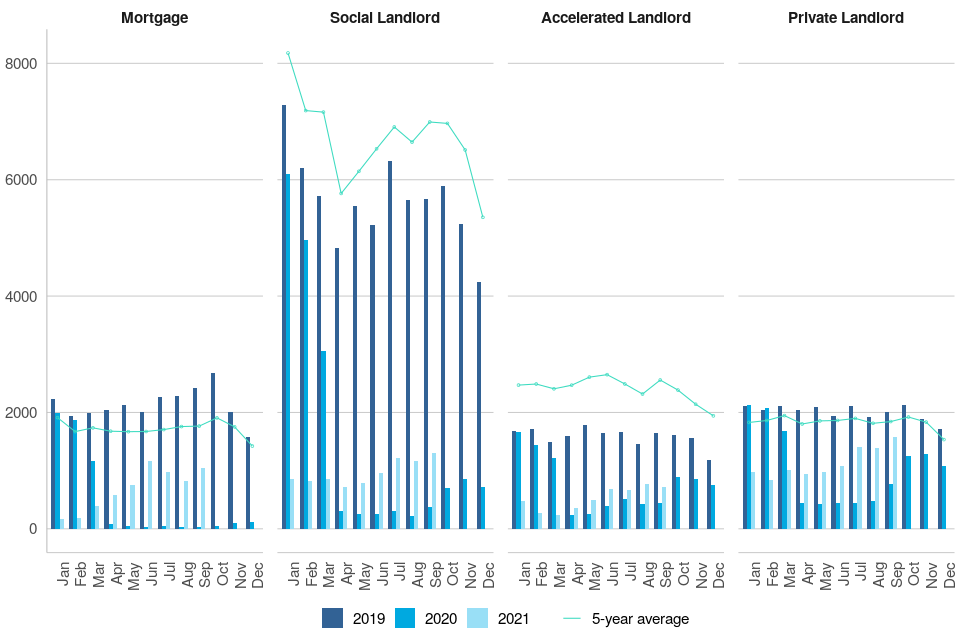
The total number of claims can be further subdivided by claim type, with Figure 10 showing the variation in claim numbers between landlord and mortgage claims.
The most significant decline was in mortgage possession claim numbers, suggesting that, overwhelmingly, mortgage lenders have complied with the FCA suspension of mortgage possession actions. Following the significant fall in claim numbers in April (79 claims, down 96% on 2019), claim numbers remained low from May to October, never exceeding 60 claims per month. From Q4 2020 to Q2 2021 there was an increasing trend: September 2021 had 1,038 claims (down 57% when compared to 2019).
Both social and private landlords showed a similar pattern. After the initial drop seen April 2020 (from 1,680 and 3,054 in March 2020 to 313 claims for social landlords 443 claims for private landlords respectively), claim numbers remained low for both landlord types. Numbers then started to increase from August to November for both social and private landlords (849 and 1,282 respectively) with both landlord types decreasing again in December (719 for social landlords and 1,085 for private landlords). However, in this most recent quarter, they both then rose to 1,297 in September 2021 for social landlords and 1,582 for private landlords. However, September was still down 77% and 21% compared to 2019 for social and private landlords respectively.
The trend has been the least consistent for accelerated landlord claims. After the drop in April (to 245 claims, down 85% on 2019), claim numbers ranged from (245 to 514) in April to September 2020, with July 2020 having the highest number. Claim numbers then rose to 899 claims in October (down 44% on 2019). From September 2020 to March 2021 there is a decreasing trend to 245 claims in March followed by a steady increase to 679 in June 2021. In September 2021 there were 714 claims. This figure is 62% higher than the claim numbers seen in September 2020 but down 57% on September 2019.
Figure 11: Possession claims where reactivation notices have been received[footnote 19], by week-commencing date
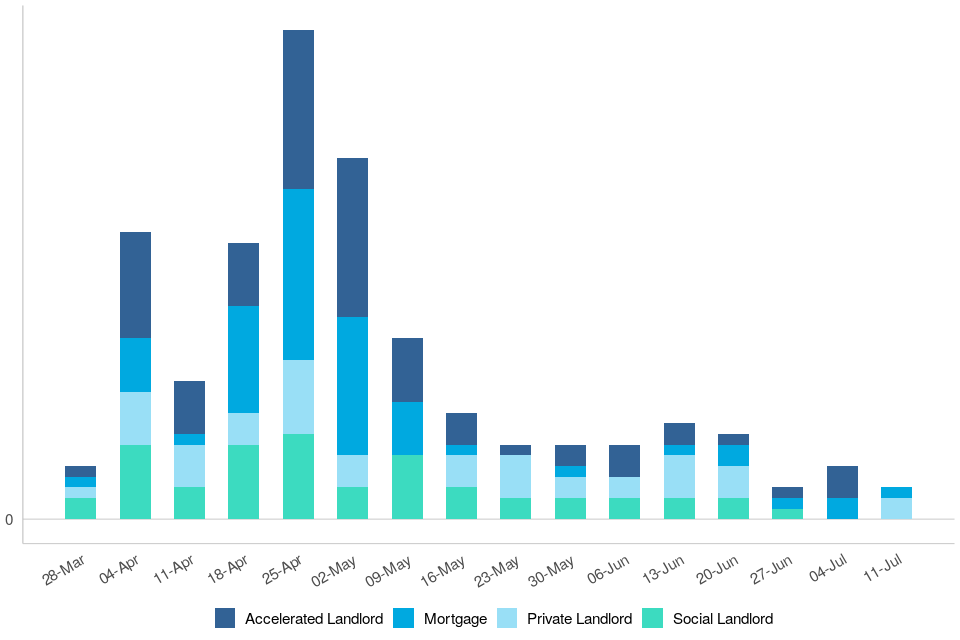
While only minimal increases in the number of new possession claims were recorded following the end of the stay in possession actions on 20 September, receipt of reactivation forms for existing claims has increased significantly since this time. During July-September 2020, 1,543 reactivation claim notices were received for claims started in 2020.[footnote 20] A further 2,720 reactivation notices were received during the fourth quarter of 2020 and 798 in the first quarter of 2021. While a small number (82) of these reactivations were submitted week commencing 23 August (the first extension date for the stay), the second extension of the possession action stay until 20 September meant that numbers dropped following this date.
Many of these reactivation requests were therefore not submitted until week commencing 20 September 2020 (893 requests in that week), with numbers falling in the subsequent months (only 40 requests in the week commencing 27 December). Following this there was an increasing trend leading up to the week commencing 24 January (212 requests). This week contained the initial deadline for reactivating claims (29 January). After which, the number of reactivation requests decreased again, plateauing to low numbers in February and March (with only 3 in the week commencing 11 July). Accelerated and private Landlord claims made up 33% and 19% of reactivated claim applications respectively.
Figure 12: Comparison of all possession warrants issued by month in the county courts of England and Wales (2019, 2020,2021 and 5-year average)

As can be seen in Figure 12, following the significant decrease in warrant volumes in March 2020, by April 2020 these numbers had fallen to just 133 warrants, down 98% on both April 2019 and the 5-year average. After decreasing further to a low of 71 warrants in May, the numbers then showed an increase in the following months leading up to October. Despite this increasing trend, and the end of the stay on possession actions in late September, October was still down 88% compared to September 2019 and down 93% compared to the five-year average. Warrant numbers then decreased in November (to 526 warrants) before increasing leading up to March 2021 (to 1,014 warrants). September 2021 (1,756 warrants) was still down 71% compared to 2019 and 75% compared to the 5-year average.
Although this increasing trend was consistent across all landlord types, mortgage warrant volumes remained low from April to August (ranging between 2 and 5 warrants). In September and October, figures showed a slight increase (to 16 warrants in September and 23 in October), but October was down 99% compared to October 2019 and the five-year average. Following this, warrant numbers were inconsistent but still low (ranging from 7 to 20 in November 2020 to March 2021). In Q2 2021, warrants increased more noticeably at 131 and 317 in May and June 2021 respectively. In September 2021 there were 283 warrants.
It should be noted that, during the suspension of possession activity, though warrants could still be issued where an individual has applied for one, that individual would have been informed that no enforcement action could be undertaken at that time.
Figure 13: Comparison of all bailiff repossessions by month in the county courts of England and Wales (2019, 2020 and 5-year average)
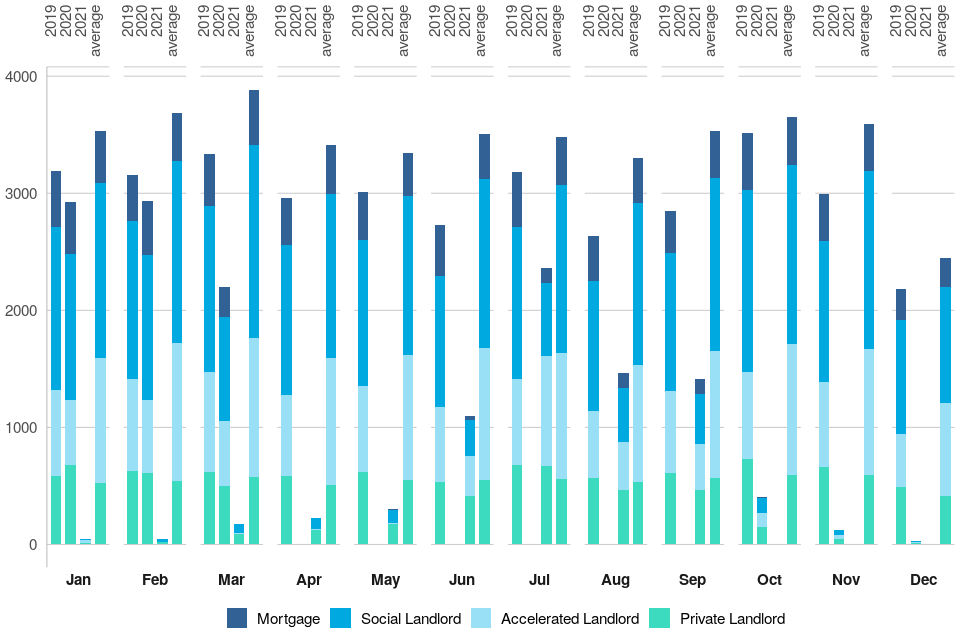
As can be seen in Figure 13, across January and February 2020 the total number of repossessions was already down on the same months of 2019 (down 8% and 13% respectively). With the start of Covid-related actions impacting from the end of March, repossession numbers were down 34% on March 2019 (to 2,197 repossessions). As expected, no repossessions were recorded in Q2 and Q3 due to the stay on repossessions. There were 407 repossessions in October (down 88% on October 2019). Numbers then dropped to lower levels in November and December (to only 121 and 29 respectively). The number of repossessions remained similarly low in January and February (48 and 46 respectively), before increasing to 178 repossessions in March 2021. This increasing trend continued in April and May (227 and 300 repossessions respectively) with the first significant rise noted in June 2021 (1,100 repossessions) followed by another rise in July 2021 (2,361 repossessions). In September 2021, the number of repossessions was down to 1,415. The figure for September 2021 is 50% below the 2019 figure and 60% below the five-year average.
Though the proportions of landlord types have remained fairly consistent throughout this period, after December, accelerated and private landlord repossessions remained considerably low. However, these have now started to increase and as a result, private and accelerated landlord repossessions made up 61% of bailiff repossessions in September 2021, compared to 46% in September 2019.
10. Further information
The statistics in the latest quarter are provisional and revisions may be made when the next edition of this bulletin is published. If revisions are needed in subsequent quarters, these will be annotated in the tables.
10.1 Accompanying files
As well as this bulletin, the following products are published as part of this release:
-
A supporting guide providing further information on how the data is collected and processed, including a guide to the csv files, as well as legislation relevant to mortgage possessions and background information.
-
A set of overview tables, covering key sections of this bulletin.
-
CSV files of the map data and the possession action volumes by local authority and county court.
-
A CSV file of the data included in the Annex.
-
A data visualisation tool which provides a detailed view of the Mortgage and Landlord statistics. We welcome feedback on this tool to help improve it in later editions and to ensure it meets user needs.
10.2 National Statistics status
National Statistics status means that official statistics meet the highest standards of trustworthiness, quality and public value.
All official statistics should comply with all aspects of the Code of Practice for Statistics. They are awarded National Statistics status following an assessment by the Authority’s regulatory arm. The Authority considers whether the statistics meet the highest standards of Code compliance, including the value they add to public decisions and debate.
It is the Ministry of Justice’s responsibility to maintain compliance with the standards expected for National Statistics. If we become concerned about whether these statistics are still meeting the appropriate standards, we will discuss any concerns with the Authority promptly. National Statistics status can be removed at any point when the highest standards are not maintained, and reinstated when the standards are restored. These statistics have been audited and re-accredited as National Statistics. The most recent compliance check completed by the Office of Statistics Regulation can be found here.
10.3 Future publications
Our statisticians regularly review the content of publications. Development of new and improved statistical outputs is usually dependent on reallocating existing resources. As part of our continual review and prioritisation, we welcome user feedback on existing outputs including content, breadth, frequency and methodology. Please send any comments you have on this publication including suggestions for further developments or reductions in content.
10.4 Contact
Press enquiries should be directed to the Department for Levelling Up, Housing and Communities press office:
email: newsdesk@communities.gov.uk
Other enquiries and feedback on these statistics should be directed to the Data and Evidence as a Service division of the Ministry of Justice:
Rita Kumi-Ampofo - email: CAJS@justice.gov.uk
Next update: 10 February 2022
© Crown Copyright
Produced by the Ministry of Justice
Alternative formats are available upon request from ESD@justice.gov.uk
-
The Overall Arrangements provide full detail on the measures that are in place and can be found here ↩
-
The law requires at least 4 and no more than 8 weeks between claim and court hearing. Possession orders stipulate when a tenant must vacate the property - typically within 4 weeks from the date the order was made. Landlords cannot issue a warrant until after this period (if the tenant has failed to comply). ↩
-
Though possession proceedings were suspended by the Civil Procedure Rules - Practice Direction 51Z, amendments have been made to allow exceptions from the stay, such as in Civil Procedure (Amendment No. 2) where claims against trespassers to which rule 55.6 applies, applications for case management directions which are agreed to by all parties and claims for injunctive relief were exempt from the stay. ↩
-
https://www.legislation.gov.uk/uksi/2020/889/article/2/made ↩
-
https://www.fca.org.uk/publications/finalised-guidance/mortgages-and-coronavirus-updated-guidance-firms ↩
-
https://www.fca.org.uk/publications/finalised-guidance/finalised-guidance-mortgages-and-coronavirus-updated-guidance-firms ↩
-
https://www.justice.gov.uk/courts/procedure-rules/civil/rules/practice-direction-55c-coronavirus-temporary-provision-in-relation-to-possession-proceedings ↩
-
https://www.justice.gov.uk/courts/procedure-rules/civil/127-cpr-update.pdf ↩
-
https://www.judiciary.uk/wp-content/uploads/2020/09/Possession-Proceedings-Overall-Arrangements-Version-1.0-17.09.20.pdf ↩
-
https://www.gov.uk/government/statistics/mortgage-and-landlord-possession-statistics-october-to-december-2020/mortgage-and-landlord-possession-statistics-october-to-december-2020#fn:8 ↩
-
https://www.legislation.gov.uk/uksi/2021/164/contents/made ↩
-
https://www.legislation.gov.uk/uksi/2021/284/contents/made ↩
-
https://www.legislation.gov.uk/wsi/2020/1490/introduction/made ↩
-
This data includes only reactivation notices received for possession claims initially made in 2020. ↩
-
Duplicate reactivation notices received for the same claim were not counted. ↩
